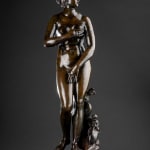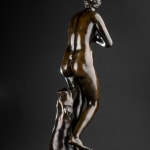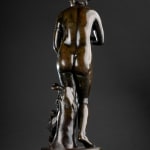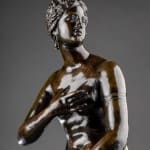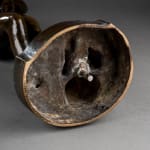Giacomo & Giovanni Zoffoli (1731-1785 & 1745 – 1805)
H 13 3/4 inch
Further images
The goddess is depicted in a fugitive, momentary pose, as if surprised in the act of emerging from the sea, to which the dolphin at her feet alludes.
The Medici Venus is one of the most celebrated antiquities. Louis XIV for example had no less than five versions of this statue. Still today we can admire multiple life size statues adorn many grand parcs in Europe. In small bronze reductions, as our statuette, it figured among the most familiar of the antiquities represented in collectors’ cabinets: in Greuze’s portrait of Claude-Henri Watelet, ca 1763-65, the connoisseur and author of L’art de peindre is shown with calipers and a notebook, regarding a bronze statuette of the Venus de’Medici, as if in the act of deducing the ideal proportions of the female figure from the sculpture’s example.
According to Piero Ligorio, the statue was found in Rome, near the Trajan Baths, inside the vineyard of Bishop of Viterbo, Sebastiano Gualtieri. It immediately became part of the prelate’s collection and in 1566, it was bought by Alfonso d’Este. In 1575 it was sold to Ferdinando de’Medici, who decided to export it to the collection of antiquities at the Villa Medici in Rome. The statue was kept in the sumptuous Roman residence for over a century. In 1677, it was moved to Florence, together with masterpieces such as the knife-grinder and the wrestlers. These famous works were exhibited in the Tribune, the most precious space of the Uffizi, and the Venus was elevated to symbolic representation of the Florentine museum in its entirety. The prestige of the statue can be seen in subsequent events and the successive collecting history. In 1802, Napoleon ordered the transfer of the statue to Paris. The French period lasted until 1816, when the statue was relocated back to its original location in Florence.
In a rare circumstance for ancient statues, the Venus has a known author. The base podium in fact bears his signature, Cleomenes, son of Apollodorus, a sculptor working in Athens during the 1st century B.C.
High-quality small replicas of this and other famous statues and busts from antiquity were produced in bronze, terracotta and porcelain, in Rome and elsewhere. In Rome during the second half of the eighteenth century, four enterprising foundries were active – those of Francesco Righetti, Luigi and Giuseppe Valadier, Giuseppe Boschi and (the largest and most popular), the foundry of Giacomo and Giovanni Zoffoli, who produced this bronze.
Hugh Honour had published the 1795 inventory of all bronzes produced by Giovanni and Giacomo Zoffoli, which includes also the Venus de Medici. Generally, several of these bronze reductions were acquired by foreign travellers on the Grand Tour.






